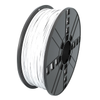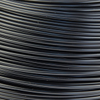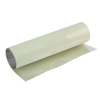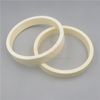Products & Services
See also: Categories | Featured Products | Technical Articles | More Information-
Supplier: Renold Jeffrey
Description: Our range of leaf chain for material handling applications is used worldwide for straddle carriers, fork lift trucks and on major civil engineering works such as flood defense barriers. We stand behind some of the largest names in the industry thanks to the quality of our products. Leaf
- Leaf Chain Series: AL Series
-
Supplier: Umicore Metal Deposition Solutions
Description: Specifications Material Type non-metals Material Al2O3 Purity 4N
- Materials Processed: Aluminum Oxide / Sapphire, Specialty / Other
- Purity: 99.99 %
- Type: Sputtering Target
-
Supplier: DigiKey
Description: 3D Printing Filament
-
-
Supplier: DigiKey
Description: 3D Printing Filament
-
Supplier: DigiKey
Description: 3D Printing Filament Black ABS (Acrylonitrile Butadiene Styrene) 0.118" (3.00mm) 2.205 lb (1.00 kg)
-
Supplier: DigiKey
Description: 3D Printing Filament White ABS (Acrylonitrile Butadiene Styrene) 0.118" (3.00mm) 2.205 lb (1.00 kg)
-
Supplier: El-Cat, Inc.
Description: EL-CAT Inc. is a stocking distributor of Silicon Wafers, Compound Semiconductors and other Crystal Materials for use in electronics.
-
Supplier: Materion Corporation
Description: Aluminum Oxide, Al2O3 Antimony Oxide, Sb2O3 Barium Oxide, BaO Barium Titanate, BaTiO3 Bismuth Oxide, Bi2O3 Bismuth Titanate, Bi4Ti3O12
- Materials Processed: Oxides
- Type: CVD / Chemical Precursor
-
Description: Alumina(Al2O3) is the most widely used advanced ceramic, Alumina Ceramic is electrical insulated, wear & corrosion resistant, high temperature resistant... Aluminum Oxide is an excellent material choice for various industries. Alumina Ceramic is the most widely
- Coeff. of Thermal Expansion (CTE): 7 to 9 µm/m-C
- Compressive / Crushing Strength: 319081 to 362592 psi
- Density: 3.7 to 3.88 g/cc
- Electrical Resistivity: 1.00E15 ohm-cm
-
Supplier: Boyd
Description: regulations like FDA, 3A Sanitary, ASTM, MIL-Spec, SAE, KTW, WRAS, ACS, Nace, Norsok, NSF-61, USP IV and UL. We strive for the highest quality, most timely shipments, and best customer service in the industry. Boyd Corporation stocks more than 150 million o-rings in eight popular
- Hardness Rating (Shore A Scale): 70 durometer, 75 durometer, 90 durometer
- Inside Diameter (ID): 0.0290 to 20.95 inch
- O-ring Sizes: "AS568" standard sizes (001-475)
- Synthetic Rubber Materials (Thermosets): Ethylene propylene rubber (EPR, EPDM, EP,EPT), Fluoroelastomer (FKM), Nitrile Rubber (NBR, HNBR, HSN ), Silicone Rubber (SiR), Other Rubber Material
-
Supplier: Morgan Advanced Materials
Description: A sintered fused silica refractory material with an SiO2 content of 99.9%
- Compressive / Crushing Strength: 2495 psi
- Density: 1.35E-9 g/cc
- MOR / Flexural Strength: 2205 psi
- Silicate and Clay Based Material Type: Silica / Fused Silica
-
Supplier: Quarktwin Technology Ltd.
Description: RF EMI Shielding Sheet AL Aluminum Foil Conductive, Single Sided 6.560" (166.00mm) X 10.000" (254.00mm) X 0.002" (0.06mm)
-
Description: and relatively traditional ceramic is alumina Al2O3. Alumina has excellent electrical insulation properties, as well as high chemical resistance and low thermal expansion. Alumina ceramic substrates can withstand high temperatures while retaining their strength and
- Shape / Form: Plate / Board (e.g., Fiberboard)
- Specialty Ceramic Type: Aluminum Nitride
-
Supplier: National Rubber Corporation
Description: complex parts Low tooling costs Good for high durometer parts Rapid production Fewer knit lines Transfer molding also utilizes a press and a mold. However, the process involves forcing the material through small holes into the mold cavity
- O-ring Sizes: Other
- Synthetic Rubber Materials (Thermosets): Silicone Rubber (SiR), Other Rubber Material
-
Supplier: Automation24, Inc.
Description: The 24 x 2 O-Ring E30054 from ifm of ethylene propylene diene rubber (EPDM) is FDA compliant and ideal for the Aseptoflex Vario process connection.
- Synthetic Rubber Materials (Thermosets): Other Rubber Material
-
Description: materials supplier. We provide high-quality Alumina ceramics at a competitive price. More Materials: Our Advanced Ceramics include: Alumina (Al2O3) Ceramics Zirconia (ZrO2) Ceramics Beryllia (BeO) Ceramics Aluminum Nitride (AlN)
- Aluminum Oxide / Aluminate Type: Alumina / Aluminum Oxide
-
Supplier: TherMark Holdings Inc.
Description: Will not work on metals with a lacquered coating, use CO2/YAG/fiber lasers
- Chemistry: Water Based
- Coverage: 41.67 ft²
- Form: Ink
- Industry: OEM / Industrial
-
Supplier: Tooling Technology
Description: Micro-porous, air-permeable aluminum is a major breakthrough! Expand thermoform design flexibility and reduce manufacturing costs with the revolutionary thermoforming mold aluminum designed to significantly enhance air evacuation and accelerate construction. Metapor micro-porous, air-permeable
- Metal / Alloy Types: Aluminum / Aluminum Alloy (UNS A)
-
Supplier: Freudenberg Sealing Technologies
Description: special shapes, making it suitable as a dynamic sealing element, for example as piston or rod seals in hydraulics. O-rings are manufactured from a wide variety of materials for all requirements.
- Synthetic Rubber Materials (Thermosets): Ethylene propylene rubber (EPR, EPDM, EP,EPT), Fluoroelastomer (FKM), Nitrile Rubber (NBR, HNBR, HSN ), Perfluoroelastomer (FFKM, FFPM), Other Rubber Material
-
Supplier: Materion Corporation
Description: Materion Microelectronics & Services offers metalized substrates developed from Beryllium Oxide (BeO) or alumina (Al2O3). The metallization can be thick film MoMn followed by plating, or direct bond copper (DBCu).
- Material Type: Alumina / Aluminum Oxide, Beryllia / Beryllium Oxide
- Shape / Form: Bar Stock
-
Description: O-Rings are the most widely used seals because they are efficient and economical and can be used in a wide variety of static and dynamic applications. O-Rings can be used to seal practically all liquid and gaseous media and they are available in elastomeric and other materials
- Cross-section: 0.0394 to 0.3937 inch
- Hardness Rating (Shore A Scale): 70 durometer
- Inside Diameter (ID): 0.3937 to 31.89 inch
- Synthetic Rubber Materials (Thermosets): Ethylene propylene rubber (EPR, EPDM, EP,EPT), Fluoroelastomer (FKM), Nitrile Rubber (NBR, HNBR, HSN )
-
Supplier: Top Seiko Co., Ltd.
Description: . Materials we machine include: Alumina, Sapphire, Aluminum Nitride, Silicon Nitride, Silicon Carbide, MMC(Metal MatrixComposites)*1, CMC(Ceramic Matrix Composites)*2, Zirconia, Steatite, Silicon, Glasses (TEMPAX Float®, Corning Glass ULE®, Fused Quartz / FusedSilica and
- CNC Machining: Yes
- Capabilities: Drilling, Milling, Turning, ID / Internal Grinding, OD / External Grinding, Surface Grinding, Wire EDM
- Location: East Asia / Pacific Only
- Materials: Ceramics, Glass, Glass Ceramics, Quartz, Sapphire / Ruby, Other
-
Supplier: Web Seal Inc.
Description: O-rings provide reliable leak-free seals and simple installation. O-rings are an ideal, cost-effective solution for many sealing situations. An O-ring is a donut-shaped ring of molded, flexible material with a round cross-section that can be either solid or hollow. These
- O-ring Sizes: "AS568" standard sizes (001-475), British Standard metric sizes, Other
-
Supplier: Acoustiblok, Inc.
Description: more sound deadening effectiveness than some treatments with lead. A typical 2 x 4 gypsum stud wall is usually 33 to 35 STC. Acoustiblok® installed in the 2 x 4 wall is lab certified at an amazing "STC of 52", better than 12" of poured concrete (STC 51). Acoustiblok's U.L.
- Features: Flameproof
- Mounting: Other
- Product Description: Acoustic Barrier / Panel
- Thickness: 0.1181 inch
-
Supplier: Linde Advanced Material Technologies
Description: /La/Zr/Ti Oxide (Custom) La/Sr/Mn Oxide (Custom) LiCo Oxide Li3PO4 Doped Li3PO4 LiMn2 Oxide PbTi Oxide PbZrTi Oxide Pb1.1Zr0.20Ti0.80 Oxide
- Applications: Electronics / Microelectronics
- Bulk Solid (Powder, Granule, Lumps, etc.): Yes
- Type: Sputtering Target
-
Supplier: Caplugs
Description: VOR Series vinyl O-Rings are designed to protect tube ends. Typically used in the automotive, scuba equipment and painting industries, these O-rings provide maximum protection against sharp edges. Available in several common sizes, Series VOR slip on easily and maintain a snug fit.
- Outside Diameter (OD): 2.25 inch
- Synthetic Rubber Materials (Thermosets): Other Rubber Material
-
Supplier: Shenzhen Dechengwang Technology Co., Ltd
Description: PTFE O Ring is mainly used for static sealing application in pipes, cylinders, bushings, stems, flanges and connections. Where chemical and physical inertia, as well as resistance to friction, temperature and ageing, are particularly strategic. For over one decade, Dechengwang has been a
- Synthetic Rubber Materials (Thermosets): Polytetrafluoroethylene (PTFE)
-
Supplier: Project Services Group, Inc.
Description: 12 Projects $400,000 -$2.5 Million Potato Chip Fryer Systems 20 Systems $150,000 -$450,000 Multi Grain Chip Lines 2 Systems $700,000 -$900,000 Potato Chip Batch & Continuous Systems 5 Systems $700,000 -$900,000 Modular Snack Food Pellet & Extruders 4 Systems $1.3 Million -
- Additional Capabilities: Powder / Bulk Handling, Cleanroom Application, Custom Equipment Design
- Capabilities: Conveyors, Lifts, Pallet Transfer Systems, Pallet Dispensers / Stackers
- Industries Served: Food / Beverage, General Industry / Manufacturing, Other
- Location: North America, United States Only, Southern US Only
-
Supplier: CASTECH, Inc.
Description: Yb:CaGdAlO4(called CALGO) is a promising new laser gain material which possess several important advantages. The crystal structure of CALGO is tetragonal. When it is pumped at 979nm under pi configuration, we can get broad emission spectra from 994nm to 1050nm in theta configuration.
- Material: Other / Specialty Material
- Type: Laser
-
Supplier: FLSmidth
Description: General The basic, durable construction of the FLSmidth Material Level Indicator permits sustained continuous operation over long periods of time. Each material level indicator consists of a head assembly coupled to a paddle shaft arrangement. This simple combination permits quick
- Device Classification: Sensor-Only
- Level Measurement Type: Continuous Level
- Material Temperature Range: 200 F
- Maximum Operating Pressure: 30 psi
-
Supplier: Seal Science, Inc.
Description: High vacuum causes elastomeric materials to lose weight and therefore volume by extracting certain absorbed gasses and other volatile components. This weight/volume loss coupled with air permeability of certain elastomer compoounds suggests that fluorocarbon materials should be
- Hardness Rating (Shore A Scale): 30 durometer, 45 durometer, 50 durometer, 55 durometer, 60 durometer, 70 durometer
- O-ring Sizes: "AS568" standard sizes (001-475), British Standard metric sizes, JIS standard sizes
- Synthetic Rubber Materials (Thermosets): Silicone Rubber (SiR), Other Rubber Material
- Thermoplastics: Thermoplastic Polyurethane (TPU)
-
Supplier: Lucas Milhaupt Global Brazing Solutions
Description: Aluminum brazing and soldering filler metals are used to join materials within the aluminum family of alloys. These materials are available in wire, strip, powder, paste (both corrosive and non-corrosive formulations) and preformed rings and shapes. Lucas-Milhaupt also offers aluminum
- Alloy: Zinc-Aluminum (Zn-Al)
- Form / Shape: Paste, Powder, Preform, Wire
- Melting Range: 725 F
-
Supplier: Fairfield Crystal Technology, LLC.
Description: Fairfield Crystal Technology uses a unique patented process to produce our Aluminum Nitride (AlN) crystals. We produce single-crystal hexagonal material for a variety of device applications. We are currently offering 5 to 10mm diameter research grade substrates.
-
Supplier: Morgan Advanced Materials
Description: A porous alumina ceramic of 99.85% Al2O3 content, especially developed as a ‘lossy’ material for microwave attenuation as typically needed in vacuum tubes.
- Density: 3.10E-9 g/cc
- MOR / Flexural Strength: 22916 psi
- Material Type: Alumina / Aluminum Oxide
-
Supplier: HP Inc.
Description: First certified material for HP Jet Fusion 3D printers. A multi-purpose affordable thermoplastic material for the production of strong parts, enabling design of lightweight structures with great color uniformity. 3D-PRINTING: WE HAVE THE RIGHT MATERIALS Evonik has
Find Suppliers by Category Top
Featured Products Top
-
 Circuit, SOS), Hybrid Microelectronics (HIC/MCM), ferromagnetic/ferroelectric thin film growth Sapphire(Al2O3) is an excellent substrate material for the epitaxial growth of various thin films. Sapphire has excellent high-temperature resistance, chemical (read more)
Circuit, SOS), Hybrid Microelectronics (HIC/MCM), ferromagnetic/ferroelectric thin film growth Sapphire(Al2O3) is an excellent substrate material for the epitaxial growth of various thin films. Sapphire has excellent high-temperature resistance, chemical (read more)
Browse Semiconducting Materials Datasheets for Hangzhou Shalom Electro-optics Technology Co., Ltd. -
 Explore cutting-edge Al2O3/AIN ceramic packages with customizable technology parameters, ensuring optimal coating thickness (Ni, Au) tailored to your specific requirements. Our packages adhere to the stringent gas tightness standards of GJB 2440A-2006 (He test), guaranteeing reliability and (read more)
Explore cutting-edge Al2O3/AIN ceramic packages with customizable technology parameters, ensuring optimal coating thickness (Ni, Au) tailored to your specific requirements. Our packages adhere to the stringent gas tightness standards of GJB 2440A-2006 (He test), guaranteeing reliability and (read more)
Browse Industrial Ceramic Materials Datasheets for Suntech Applied Materials (Hefei) Co.,Ltd -
 mount transistors, and power diodes. Due to its good thermal and electrical properties, AlN has gradually become the preferred material for this type of substrate design and can be used as insulating substrates for high-power devices, heat dissipation substrates for VLSI and packaging substrates (read more)
mount transistors, and power diodes. Due to its good thermal and electrical properties, AlN has gradually become the preferred material for this type of substrate design and can be used as insulating substrates for high-power devices, heat dissipation substrates for VLSI and packaging substrates (read more)
Browse Industrial Ceramic Materials Datasheets for Xiamen Innovacera Advanced Materials Co., Ltd. -
 ceramics), as the thermal expansion coefficient of silicon is similar, as a new generation of ceramic materials, more and more people pay attention to it. Regular Size: For Package Type: TO-3P / TO-220 / TO-247 / TO-264 / TO-3/TO-254/TO-257/TO-258, With Hole (read more)
ceramics), as the thermal expansion coefficient of silicon is similar, as a new generation of ceramic materials, more and more people pay attention to it. Regular Size: For Package Type: TO-3P / TO-220 / TO-247 / TO-264 / TO-3/TO-254/TO-257/TO-258, With Hole (read more)
Browse Industrial Ceramic Materials Datasheets for Xiamen Innovacera Advanced Materials Co., Ltd. -
 EP30LTE-2 is a highly dimensionally stable epoxy system with low linear and volumetric shrinkage upon curing. The (read more)
EP30LTE-2 is a highly dimensionally stable epoxy system with low linear and volumetric shrinkage upon curing. The (read more)
Browse Thermal Compounds and Thermal Interface Materials Datasheets for Master Bond, Inc. -
 Raise3D Announces 32 New Industrial Filaments for E2CF 3D Printer The E2CF is the 3D printer based on the E2 3D printer platform and specifically optimized for fiber (read more)
Raise3D Announces 32 New Industrial Filaments for E2CF 3D Printer The E2CF is the 3D printer based on the E2 3D printer platform and specifically optimized for fiber (read more)
Browse 3D Printing and Additive Manufacturing Materials Datasheets for Raise3D Technologies, Inc. -
 Featuring a silver filler, EP3HTS-LO is electrically conductive with a low volume resistivity of less than 0.001 ohm-cm. It also has a thermal conductivity of 12-15 BTU•in/(ft²•hr•°F) [1.73-2.16 W/(m·K)]. EP3HTS is dimensionally stable and bonds well to metals (read more)
Featuring a silver filler, EP3HTS-LO is electrically conductive with a low volume resistivity of less than 0.001 ohm-cm. It also has a thermal conductivity of 12-15 BTU•in/(ft²•hr•°F) [1.73-2.16 W/(m·K)]. EP3HTS is dimensionally stable and bonds well to metals (read more)
Browse Thermal Compounds and Thermal Interface Materials Datasheets for Master Bond, Inc. -
 MCPP is one of the world’s largest polymer based 3d filament manufacturers with a focus on high (OEM) quality filaments and the development of new innovative materials for 3D printing based on FDM and / or FGF technology. (read more)
MCPP is one of the world’s largest polymer based 3d filament manufacturers with a focus on high (OEM) quality filaments and the development of new innovative materials for 3D printing based on FDM and / or FGF technology. (read more)
Browse 3D Printing and Additive Manufacturing Materials Datasheets for MCG - Performance Polymers Division -
 fine silica gels are spherical and highly pure. The pore structure, spherical shape and particle distribution of SOLESPHERE and are precisely defined. They are available in particle sizes from 3µm to 20µm and have surface areas ranging between 40-800 m2/g. SOLESPHERE silica are very (read more)
fine silica gels are spherical and highly pure. The pore structure, spherical shape and particle distribution of SOLESPHERE and are precisely defined. They are available in particle sizes from 3µm to 20µm and have surface areas ranging between 40-800 m2/g. SOLESPHERE silica are very (read more)
Browse Datasheets for AGC Chemicals Americas, Inc. -
 multiple point measurement data from two or more 3DLevelScanners to cover a very wide surface area which makes it able to estimate inventory volume with greater accuracy than previously available from any level measurement device. Using advanced processing and software, the MVL also displays a visual representation of the material surface that shows high and low points in the bin such as cone up, cone down, sidewall buildup, or bridging. (read more)
multiple point measurement data from two or more 3DLevelScanners to cover a very wide surface area which makes it able to estimate inventory volume with greater accuracy than previously available from any level measurement device. Using advanced processing and software, the MVL also displays a visual representation of the material surface that shows high and low points in the bin such as cone up, cone down, sidewall buildup, or bridging. (read more)
Browse Dry Material (Powders) Level Sensors Datasheets for BinMaster, Inc.
Conduct Research Top
-
What Is The Best Ceramic Substrate Material?
The ceramic substrate material in an electronic packaging system is the key to getting rid of heat efficiently. It should also be strong and reliable so it can handle the complexity of the work environment. The ceramic substrates that have been mass-produced and widely used in recent years
-
Commonly Used Wave-transmitting Ceramic Materials for Microwave Heating: Oxide Ceramic System
The commonly used oxides of wave-transmitting materials for microwave heating mainly include fused silica, glass-ceramic, alumina-based ceramics, etc. Among them, fused silica has stable chemical properties, high thermal shock resistance and excellent dielectric properties due to its atomic
-
Alumina 94%
Alumina is produced by firing a tightly packed powder form of Al2O3 which includes some binder material.
-
Growing Hydrogen Expectations : Embedded Catalyst Design for Active and Stable Catalysts (.pdf)
The mass spectrometer was used to prove the superior thermal stability, during methane partial oxidation Figure 1, of an innovative embedded Rh@Al2O3 catalyst with respect to conventional impregnated material
-
What are the Defects on the Surface of Alumina Ceramics?
Alumina ceramics is a kind of ceramic material with Al2O3 as the main raw material. It has many advantages, such as high mechanical strength, high hardness, and low dielectric loss at high frequencies, so it is widely used in the fields of electronics, electrical appliances, machinery, textiles
-
Partial Pressure Control in Reactive Sputtering (.pdf)
Reactive Sputtering is used to produce functional coatings having properties that are suitable for a range of applications such as decorative, wear resistant, optical and magnetic thin films. In Reactive Sputtering a target material (e.g. titanium or aluminium) is sputtered in the presence
-
Direct Bonded Copper Ceramic Substrates
DBC ceramic substrate, short for Direct Bonded Copper Ceramic substrate, is an advanced material composed of a ceramic substrate (typically Al2O3 or AlN) and copper, tightly joined together through a hypo-eutectic process. This unique combination of materials results in a substrate with exceptional
-
Borosilicate Glass (PYREX 7740; Schott 8330)
Borosilicate glass is composed of 80.6% SiO2, 12.6% NaO2, 2.2% Al2O3 and traces of other key materials. This glass was formulated to achieve excellent thermal shock resistance and high-temperature resistance. Additional benefits include low thermal expansion and high resistance to chemical attack
More Information Top
-
The Dissertation Committee for Danielle Salina Applestone Certifies that this is the
approved version of the following dissertation:
SYNTHESIS AND CHARACTERIZA...
Figure 4.2(a) is of the Cu2Sb- Al2O3 material .
-
Performance Improvement of NOx -Storage BaO/Al2 O3 by Using Barium Peroxide as the Precursor of BaO
Abstract Comparison of barium peroxide, Ba(OH)2 and Ba(NO3)2 as the precursor of BaO for the preparation of NOx-storage BaO/ Al2O3 material was carried out.
-
Bulk Ceramic Composites Derived from a Preceramic Polysilazane with Alumina and Zirconia Fillers
During sieving of the coated filler powders, the PVS/ Al2O3 material formed soft agglomerates.
-
Phase Relations and Microstructural Development of Aluminum Nitride–Aluminum Nitride Polytypoid Composites in the Aluminum Nitride–Alumina–Yttria System
The density decreases linearly with the Al2O3 content to 93% of theoretical density for the 16.6 mol% Al2O3 material .
-
Particle fracture, retention, and fluid flow in metal matrix composite friction joints
During dissimilar alloy 6061/AISI 304 stainless steel joining, the axial length of the component containing the 500-m-thick capping of alloy 6061/ Al2O3 material de- creased by 9 mm.
-
Microstructural and Mechanical Characterization of Ti-12Mo-6Zr Biomaterials Fabricated by Spark Plasma Sintering
Four representative peaks were detected for the constituents (Ti, Mo, Zr, and alumina) of the prepared Ti-12Mo-6Zr/ Al2O3 materials .
-
Synthetic Coal Slag Infiltration into Varying Refractory Materials
Minimal penetration was observed in the 90%Cr2O3–10% Al2O3 material because interactions between the refractory and the slag produced a protective layer of FeCr2O4, which impeded slag flow into the bulk of the refractory.
-
Functional Materials and Nanotechnology
Effects of Calcination Time on Structure and Morphology of Porous TiO2- Al2O3 Material .




























 Indicates content that may require registration and/or purchase.
Indicates content that may require registration and/or purchase.
